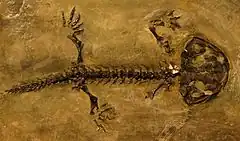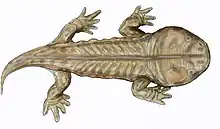Karaurus
Karaurus (meaning head-tail) is an extinct genus of stem-group salamander (Caudata) from the Middle to Late Jurassic (Callovian–Kimmeridgian) Karabastau Formation of Kazakhstan. It is one of the oldest salamanders known.
| Karaurus Temporal range: Late Jurassic | |
|---|---|
 | |
| Fossil skeleton | |
| Scientific classification | |
| Domain: | Eukaryota |
| Kingdom: | Animalia |
| Phylum: | Chordata |
| Class: | Amphibia |
| Clade: | Caudata |
| Family: | †Karauridae |
| Genus: | †Karaurus Ivachnenko, 1978 |
| Type species | |
| †Karaurus sharovi Ivachnenko, 1978 | |
Karaurus was large for a Jurassic salamander, about 20 centimetres (7.9 in) long, and very similar anatomically to modern salamanders. Karaurus is thought to have fed using suction feeding via the enlargement of the buccal cavity on small fish and invertebrates, with the well-developed palatal dentition (teeth on the roof of the mouth) and marginal teeth helping to grasp prey.[2] Karaurus is thought to form a clade with Kokartus from the Middle Jurassic (Bathonian) of Kyrgyzstan, and Marmorerpeton from the Bathonian of Britain, together forming the Karauridae, which are closely related to crown salamanders.[3] Like other members of Karauridae, Karaurus is neotenic.[2]
References
- "†Karaurus Ivachnenko 1978". Paleobiology Database. Fossilworks. Retrieved 17 December 2021.
- Skutschas, Pavel; Martin, Thomas (April 2011). "Cranial anatomy of the stem salamander Kokartus honorarius (Amphibia: Caudata) from the Middle Jurassic of Kyrgyzstan: SKULL OF JURASSIC STEM SALAMANDER". Zoological Journal of the Linnean Society. 161 (4): 816–838. doi:10.1111/j.1096-3642.2010.00663.x.
- Jones, Marc E. H.; Benson, Roger B. J.; Skutschas, Pavel; Hill, Lucy; Panciroli, Elsa; Schmitt, Armin D.; Walsh, Stig A.; Evans, Susan E. (2022-07-11). "Middle Jurassic fossils document an early stage in salamander evolution". Proceedings of the National Academy of Sciences. 119 (30): e2114100119. Bibcode:2022PNAS..11914100J. doi:10.1073/pnas.2114100119. ISSN 0027-8424. PMC 9335269. PMID 35858401.
